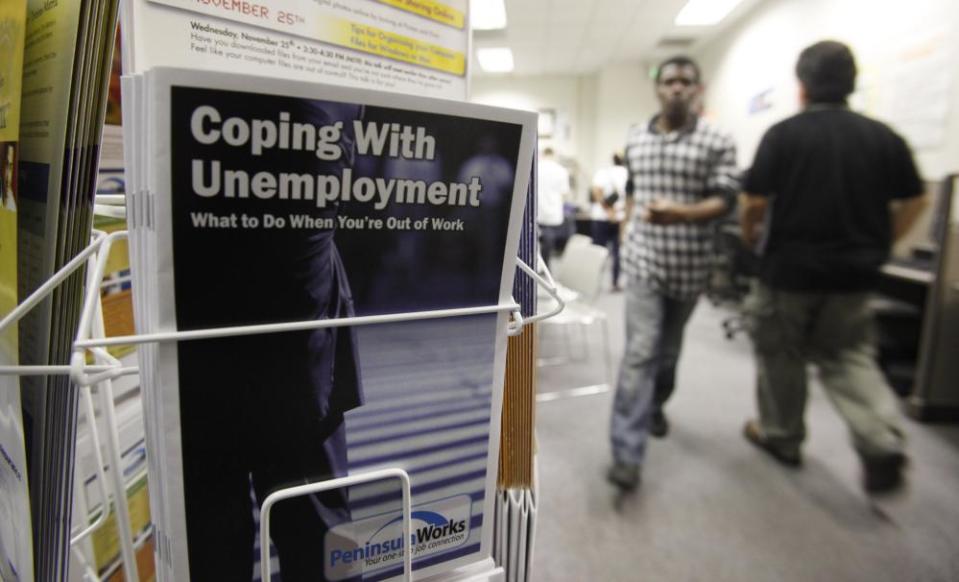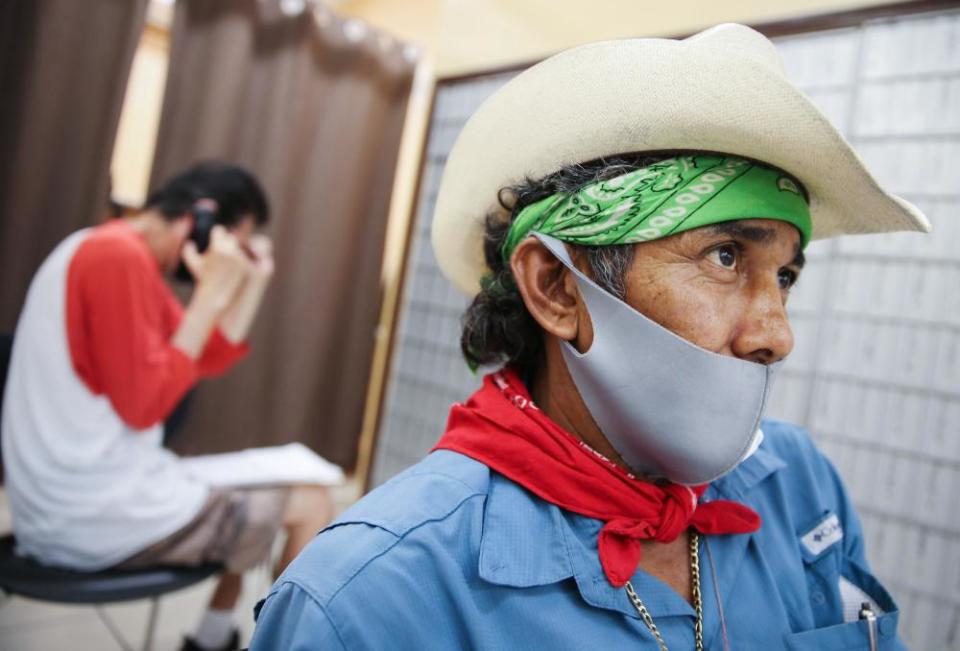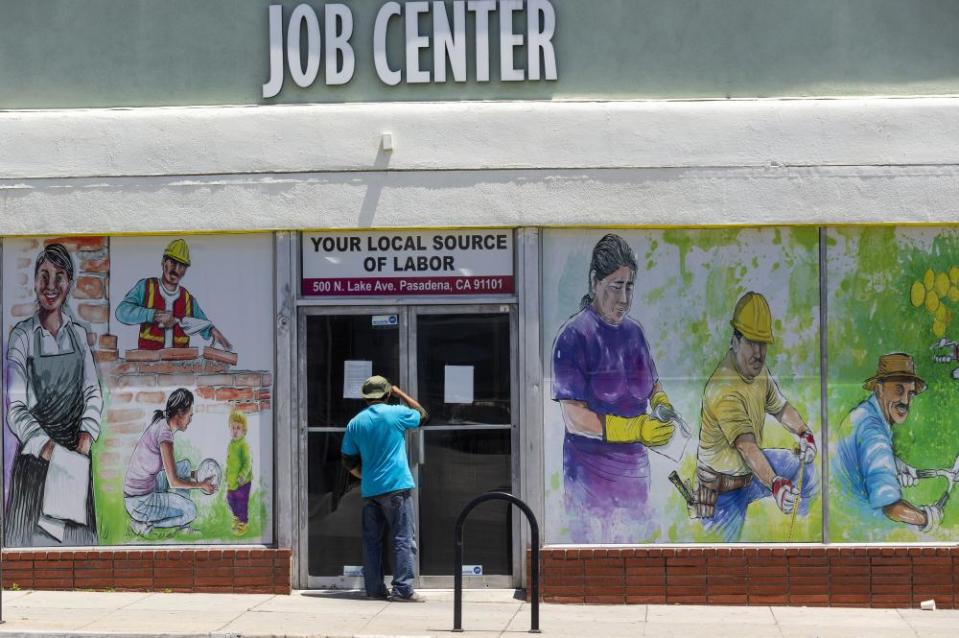'I'm drowning': Californians of color most affected by growing backlog of jobless aid
At her lowest point during the pandemic, Rachel Gomez-Wafer estimated that she was calling California’s unemployment office about 150 times a day.
When California shut down in March, the boutiques where Gomez-Wafer sells her organic skincare line, Dorothy Mae and Dominga, closed. The craft fairs and festivals where she makes most of her profits were canceled. She applied on 4 April for the pandemic unemployment assistance that was available to her as a small business owner but, like hundreds of thousands of other Californians who have filed for unemployment benefits, she soon found herself tangled in a months-long bureaucratic nightmare.
Nearly one-third of all Californian workers have filed for unemployment benefits since the start of the crisis in mid-March – 6.23 million workers, according to the California Policy Lab. A recent report from a strike team found that the Employment Development Department (EDD), the office in charge of issuing unemployment benefits, had a backlog of claims so large that the department had to stop accepting new claims for two weeks in order to get a handle on it. The department believes its employees won’t be able to eliminate the backlog of 1.6m before January 2021. The backlog grows by 10,000 cases a day.
Related: The 'shecession': why economic crisis is affecting women more than men
In waiting for her claims, Gomez-Wafer burned through her savings. She soon had no food in her refrigerator. Repossession agents were calling her about her missing car payments, and her landlord had given her a three-day eviction notice – illegal during the pandemic – on her studio loft in Fresno. “I borrowed money from my dad, I borrowed money from my daughter, I borrowed money from my best friend,” said Gomez-Wafer, 44. “I pawned a pair of diamond earrings. I pawned a TV I owned. I pawned some gold jewelry.”
“I’m a pretty strong person. My family is really proud of me,” she said through tears. “But privately, I feel like I’m drowning. I feel like I’m under water.”

Ten years ago, California’s state legislature held hearings on how the state’s archaic technical system caused a backlog of unemployment claims during the Great Recession. “The legislative descriptions of what happened a decade ago could have been dated for 2020 and been applicable today,” said David Chiu, state assemblymember.
Since the start of the pandemicChiu’s office – and pretty much every other legislative office throughout California – has become, by extension, an EDD crisis helpline for their constituents. “We hear on an hourly basis from desperate constituents who have gone into extremes, depleted their life savings, are struggling to put food on the table and pay their rent,” he said.
The report, Chiu said, told legislators a lot of what they already knew: EDD needed a massive overhaul of its technology systems and was chronically understaffed. There were confusing processes, long waits, repeated forms, unanswered phone calls that, when answered, often can’t be resolved.
Between new unemployment insurance programs such as pandemic unemployment assistance and a surge in claims unlike anything seen before, the department was completely overwhelmed in a time of crisis.
But the report also noted that “individuals who are not fluent in English face insurmountable barriers to receiving assistance”. It found that the claims website did not work on mobile phone, meaning users had to have access to desktop computers in order to file a claim – something that was not available to many low-income communities when public libraries were closed during the pandemic. The report stated that 39% of users in June used mobile devices to file a claim, and 70% of those who accessed the EDD website had used a mobile device.
“In a state as diverse as California, it’s yet another example of how we’re seeing racial inequities play out,” Chiu said. “Those individuals who may lack computer or Internet access or have limited English proficiency tend to be people of color, and that means they’re being severely hamstrung by this broken bureaucracy.”

Further exacerbating matters is that in California, the pandemic recession has not hit everyone equally. Unemployment rates remain higher for Californians of color than for white Californians, according to a study by the California Budget and Policy Center. At its peak, unemployment reached 20% or more for Asian, Black, Latinx and other Californians of color, while hitting 17% for white Californians. Women bore the brunt of unemployment, with 1 in 4 out of work at the worst point of the recession, as compared to 1 in 5 men.
And while the state gained back 34% of the 2.6m jobs it lost in March and April, and the unemployment rate for white Californians dropped from its peak of 17% to 13% in August, they remained almost the same for Black Californians, dropping just 1percentage point from 20% to 19%. “It’s hard not to think discrimination is not a factor there,” said Alissa Anderson, study author and senior policy analyst with the California Budget and Policy Center.
Anderson said that while the backlog needs to be fixed, “the other critical part of this is that federal lawmakers have not provided any other economical relief since March”. “When I look at these numbers, the clear takeaway is that lawmakers, both federal and local, absolutely need to do more to help people through this crisis or we will be looking at economic scars that will last a lifetime, and those scars will be much deeper for black and brown Californians,” she said.
Almost overnight in March, 90% of the members of Unite Here Local 11, a union representing hospitality workers in southern California and Arizona, lost their jobs. Many of the 32,000 members are Latinx and immigrants. The union itself had to lay off some of its staff, so Jeremy Blasi, the union’s general counsel, asked volunteers at the local law schools and universities to help their members navigate EDD.
The union came across the same issues that so many other unemployed Californians have experienced in filing for unemployment. They had to set up two separate clinics: one to help members with their initial applications, and another to help members whose applications were rejected and needed further assistance, or who never heard back from EDD.
“Our union, after the Great Depression, was involved in setting up the unemployment system,” Blasi said. “To see the program after many years be whittled down and attacked, primarily by Republicans who have wanted to make it as difficult as possible for people to get benefits, is enraging. The system should have been designed precisely for a situation where a lot of people would be left unemployed all at once. We know the EDD staff is working hard but they’re working with totally antiquated technology and a set of regulations that create far too many opportunities for workers to fall through the cracks.”

After almost four months of back-and-forth with EDD, Leah, who asked that her last name not be printed for privacy reasons, started the Twitter account, @CAUnemployed, so that Californians like her could share tips about how to get through to EDD – as well as their horror stories.
Leah was furloughed from her bartending and serving job at a West Hollywood hotel in March. She immediately applied for unemployment, thinking it wouldn’t be a difficult process. Her sister, whom she was living with, had gotten her unemployment benefits within 10 days. But Leah found out she had to mail in her documents, and then she didn’t get a call back for several months. “I started calling EDD, and you can’t get through to EDD. You just can’t,” she said. “It became a job for me, calling.”
She received a set of documents in the mail from EDD that were all in Spanish, which she did not speak, but she was able to figure out that they said she did not qualify. She kept calling. Someone said they would call her back. “I would always stay by my phone,” Leah said. “Even when I took a shower, my sister would watch my phone and the call never came.”
She eventually got approved after contacting her state assembly member twice and starting the Twitter page. On the page, she’d retweet phone numbers to various district EDD offices at which some said they had luck getting through to a person.
“I came out relatively unscathed but it still did a number on me, mentally and emotionally,” Leah said. “It takes away a bit of your dignity. Here you are, jobless due to nothing that you’ve done, no fault of your own. Now you have to rely on other people to make ends meet and you can’t even get someone to answer the phone.”
For Gomez-Wafer, the Fresno small business owner, she received a letter three months after her initial application in April saying she had been approved for pandemic unemployment assistance. But she never received the forms she needed, and the department told her she had to fill out another claim.
In all, she ended up filing four. This week, she received a $7,000 check for thirteen weeks, but she’s owed for 26 weeks. When she asked EDD about it, they told her she needed to file a fifth claim.
Gomez-Wafer wished that the state officials who should have overhauled the system before a crisis hit could have looked into her refrigerator on the nights it sat empty, or listened to her begging to keep her car.
“The system is broken, point blank,” she said. “It’s broken enough that it actually broke me.”

 Yahoo News
Yahoo News 